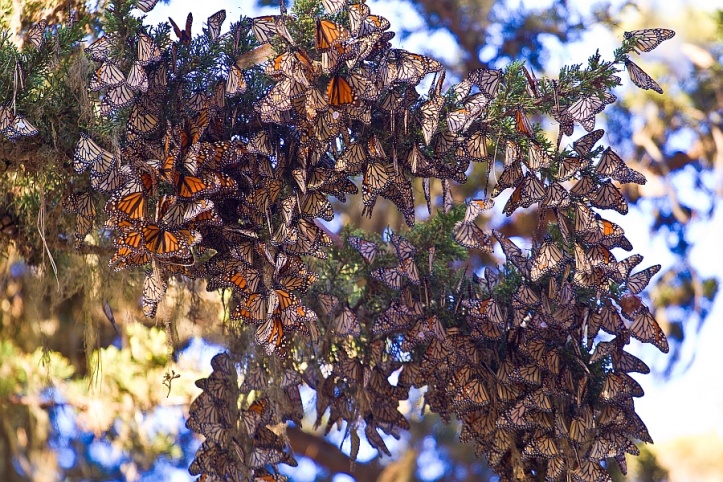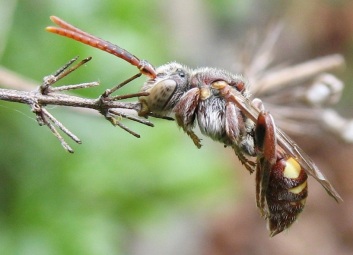
by chelsea schuyler
Sleeping is Complicated
Where do insects go at night? Which inevitably begs the question, do insects sleep?
“Sleep” is the wrong word really. They call it “state of torpor” in insects, because it makes you have to say “state of” and that sounds more Star Trekian, which is where all insect behavior is derived.

Sleep in mammals is complicated. Brain functions, hormones, and neuron inhibitors have to work together to achieve it, including one that effectively paralyzes all voluntary muscle movement. Imagine if you acted out your dreams physically – or just the hilarious reality, like this dog who apparently has nonfunctional sleep paralysis:
Reading about sleep in mammals includes words like “cholinergic agonists,” “mesencephalic,” and “pedunculopontine tegmental nucleus,” all of which cause Strabismus, the condition of being cross-eyed.

Insects keep it more simple, they just sit. They become slow to respond to stimuli, but never go into REM or any of that weirdness. Many bees sleep with their legs curled up underneath them, biting a stem or leaf to hold steady.
These insects still have a basic awareness of their surroundings (so you just have to tap on the glass harder and more often to get them to fly around again). Basically, at night, they just stop somewhere for hours. But some are weirder than others.
Winter Option 1: Death
So what about the ultimate night: winter? One option is death, but secretly laying eggs at the last minute that stay dormant until spring.
This method is very unpopular in mammals, especially this mammal, who hates movies where the main character dies but you’re supposed to feel all better cuz they popped out some fetus beforehand, so they’re not “really” gone. Except they totally are and now there’s just a dependent mouth to feed. (see Premonition, Turner & Hooch,…)

Ants head below the frost line to a store of food (Ant Pant-ry). Some insects migrate to warmer climes, like monarch butterflies. Many species enter a state of diapause, the insect version of hibernation. Again, eyes open, but not quite there. The human equivalent is called “com-pew-ter games.” Ladybugs all hibernate together in one giant reddening:

Winter Option 2: Join ‘Em

Some insects just have to deal with being friggin cold. But if their body fluids freeze, they can suffer irreparable tissue damage due to the expanding nature of ice (ice being cold as ice and willing to sacrifice our love).
What to do? Well, there are freeze-avoidant insects that defy it, and freeze-tolerant insects that become it.
Freeze avoidant (or freeze intolerant) insects create their own anti-freeze, producing glycerol (the natural version of the same stuff we use in our cars), which blocks hydrogen bonding in water molecules, preventing the formation of crystal structures (ice) until the temperature gets much lower.
Some moths do this, but for many it depends on what stage of their life cycle they’re in. Eggs, larvae, or pupae survive, while adults don’t.

Caterpillars overwinter under leaves (which is why you should simply rake your leaves to the side or special area of your yard, rather than getting rid of them entirely. Insects are people too!
Other insects are weirder. The thing is, ice crystals need to grasp on to something in order to form, like dust particles, bacteria, or anything teenie and solid, called “seeds” or “nucleators.” Without the presence of nucleators, water will remain a liquid until -42°C (-43°F)! So some insects stop eating to prevent the intake of nucleators, and some insects actually shed their gut during the molting phase! Suck it, Jenny Craig.

Freeze tolerant insects have a freaky protein that can induce ice crystals at high temperatures in order to control where they form, so as not to damage key cells and organs. The New Zealand megacricket, called the weta, does this.
You can find an ice cube weta one evening, and a functioning, moving weta the next.
images in the public domain EXCEPT:
monarch tree – photo by Agunther, CC BY 3.0
bee biting stick – photo by Giles Gonthier, CC BY 2.0
weta – photo by joketrekker, CC BY 3.0
ladybugs – photo by James St. John, CC BY 2.0

“Sleeping” while biting onto the end of a leaf is the coolest thing ever! If i could do that AND have a prehensile tail, I wouldn’t ever want anything else….or would I ? I mean x-ray vision would be pretty boss!
LikeLike
I know, or the whole flying thing, or the retaining-every-piece-of-information thing,…such debates in super power bartering.
LikeLike
Screw all those super powers. I’d settle for the ability to automatically produce cotton candy. Ummm, cotton candy. But seriously, folks, bugs are cool! And can anyone second my emotion (that emotion being total disgust mingled with intrigue) at the thought of an insect “shedding their gut?!” In your face, Jenny Craig!
LikeLike